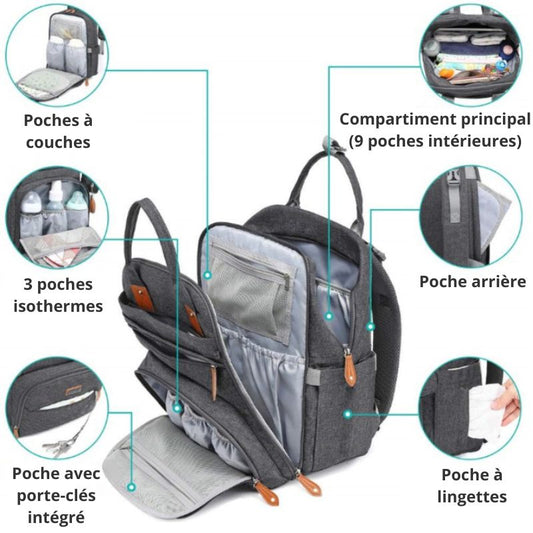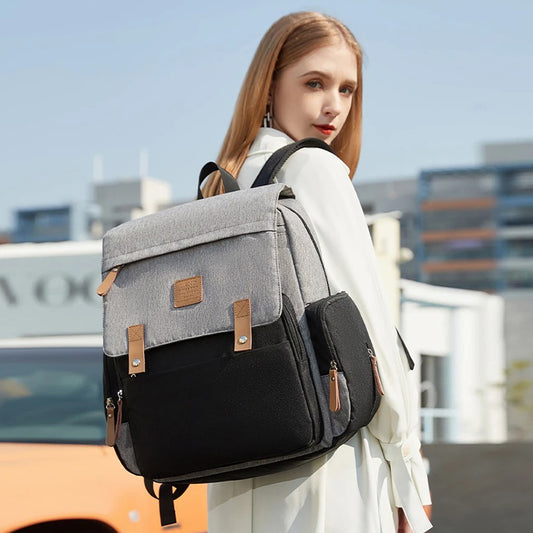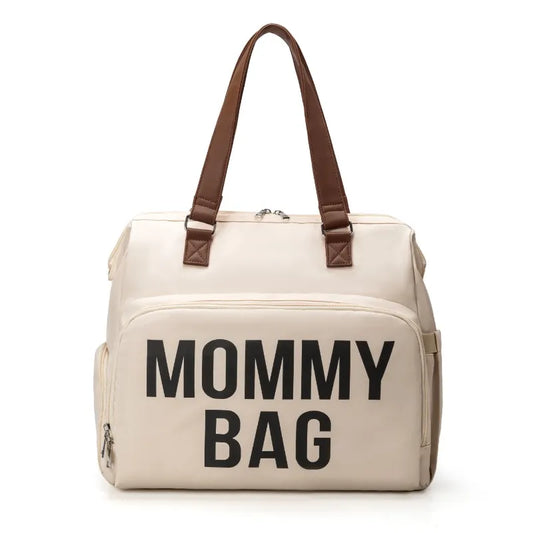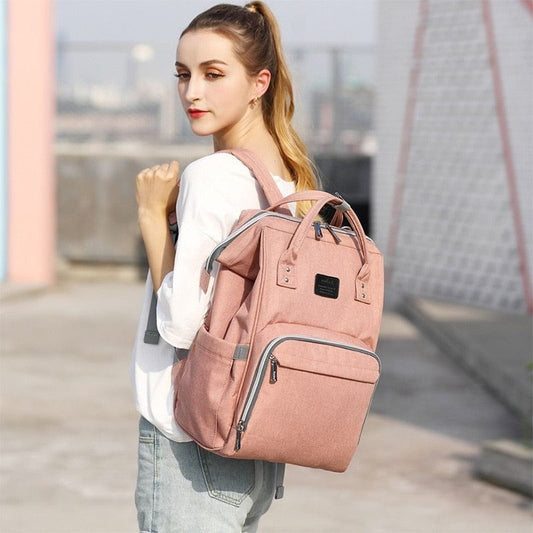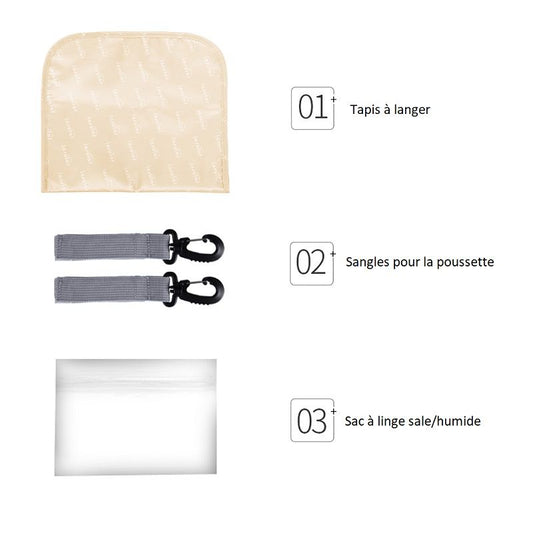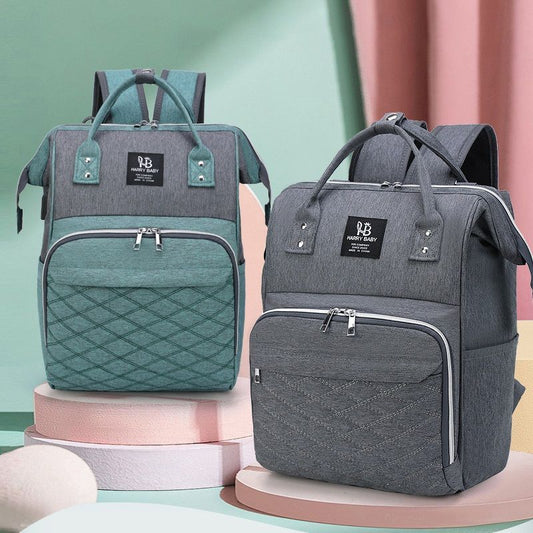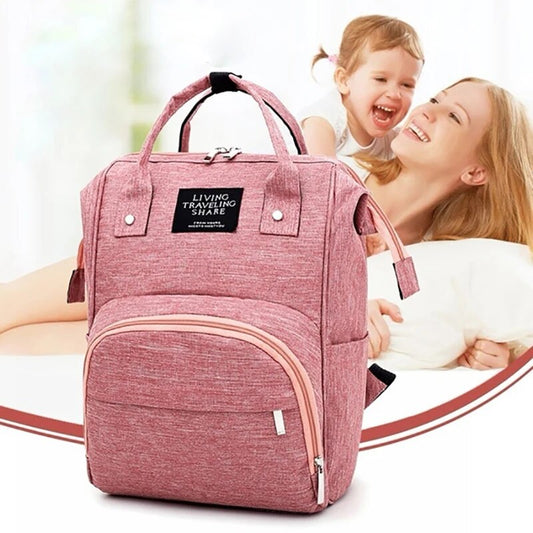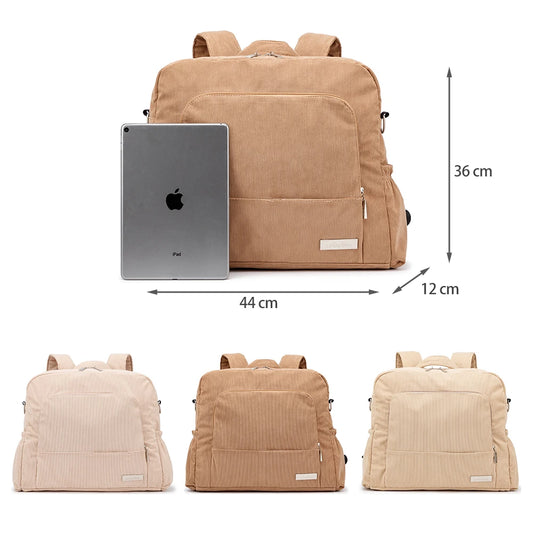Many parents begin potty training between the ages of two and three, but it is possible to start much earlier. Across the world, potty training often begins in the first year of life, sometimes as early as three to six months. The process of potty training a non-verbal, non-mobile child is called "elimination communication." In reality, elimination communication is more about parent training than child training. After learning to recognize the signs (facial expressions, fidgeting, gas, etc.), parents carry their babies to an appropriate container to collect waste. Because elimination communication requires so much parental vigilance (and cleanup!), I'm not a fan of the process; but if you have the time and patience, go for it. Less money spent on diapers, and less solid waste thrown into landfills, is better!
Discover our Diaper Bags collection.
The bottom line with potty training is that children become potty trained when parents decide they are ready. Potty training can be time-consuming and messy, so parents need to be invested in the process. A common misconception is that parents should wait until the child is ready to start learning, but this is not the case at all. Let me repeat that. There is NO need to wait until the child is ready, especially because you may find yourself waiting much longer than expected. In my experience, parents who comply with the wishes of little dictators often encounter potty problems. Two and three year olds can be incredibly stubborn and controlling. They love the word “No!” and use it generously. Before you know it, that demanding two-year-old is four, and no one wants to change a four-year-old's diaper.
When is the best time to start?
Around 18 months, most children are walking, communicating (at least nonverbally), seeking to please their parents, and are very sensitive to bribes. In my opinion, this is a fantastic time to start learning. Keep in mind that all children develop at their own pace. Children with cognitive disabilities may take longer to train, and those who walk/talk at a young age may train sooner. The good news is that almost all children can be successfully trained by employing the right strategies — a combination of positive and negative reinforcement that will motivate the child.
Personal Anecdotes About Potty Training
Before I get into the details of potty training, I'd like to share a few fun stories about my own children, who taught me almost everything I needed to know about potty training. Shortly after my oldest turned two, she literally threw a diaper at me and proclaimed, "No more diapers! I want underwear!" Princess Anna had spoken, so I shrugged, bought some underwear and that was it. The child was completely potty trained within a weekend, without any effort on my part. Moral of the story ? If a child is motivated, potty training is a breeze.
When my middle child was 18 months old, I was spending a fortune on daycare and decided it would be nice to spend less money on diapers. Our family actively began learning, which turned out to be a lot of work with lots of reminders and celebratory songs, but within two months we were done.
If a child can be completely potty trained at 20 months, I reasoned, why not start earlier? With daughter number three, we opted for an experiment and started training at 15 months. Although it required even more commitment and frequent encouragement (not to mention more laundry), the experiment was successful. At 17 months, we were done. Maybe if we had a fourth child, we would have attempted the process at an even younger age, but we never got to that point — our next child was a puppy, and Chewy took the longest to everyone's training.
Step-by-Step Guide to Potty Training
1. Parents must decide they are “ready” to train their child. This is crucial. Potty training doesn't work without full parental commitment. To prepare for this project, develop a celebration song (for example, “Sally peed, pee on the potty, yay—Sally, yay—Sally,” or something along those lines). You can also choreograph a simple dance to accompany your song. I'm serious. Children feel the energy (or lack thereof) that parents bring to their potty training routines.
2. Take your child to the bathroom with you. Show how grown-ups use the potty. If you have a moment where your child is not wearing a diaper and pees in front of you (in the bathtub, for example), point out the exciting event that just happened. Enthusiastically, you can say something like, "Look at that, you peed, hooray! Big girls pee in the potty, and you can do it too!"
3. When your child poops in a diaper, transfer the poop to the potty. Together, you can flush the toilet and happily say, “Goodbye, poop!”
4. Buy underwear. Instead of a diaper bag, carry a bag of "change of clothes," including socks and maybe shoes (pee accidents often soak feet up to the ankles).
5. Buy a plastic ring to put on the large pot. This allows little butts to sit comfortably on a normal toilet. Starting with an adult toilet minimizes cleaning tasks and the need to transition later. However, if your child is not comfortable sitting on a large potty, do not hesitate to purchase a small plastic potty that you can place in the living room or elsewhere. Have your child practice sitting on different potties. Offer lots of praise when she does.
6. Dress your child in underwear while he or she is awake, but always use diapers for naps and nighttime. Dryness during sleep is a distinct stage related to the maturity of the bladder muscles and has nothing to do with daytime dryness. Children who are completely potty trained may take several years or even 10 years (or more) to reach complete nighttime dryness. Believe me, it's not worth using underwear at night if your child usually wakes up wet; you'll find yourself doing a lot of laundry, and your child won't reach dryness any faster.
7. Watch the clock. Encourage your child to pee on the potty every one to two hours. If you encounter resistance to sitting on the potty, try using positive reinforcement (also known as bribing, see below).
8. Allow your child to have a few accidents. Try not to get angry or frustrated when they happen. The process of having accidents (and feeling them) is what motivates children to pee in the potty. When your child has an accident, encourage her to take responsibility by cleaning up any mess on the floor and putting her clothes in the washing machine. Showing a little disappointment is okay. You can say something like, "Next time, let's try putting it in the potty."
9. When your child successfully uses the potty, sing your potty song and do the pee dance. Your children will love it! The more festive the experience, the better. The first time a child uses the potty is a truly wonderful moment, so make the most of it! Singing and dancing may be the cheapest (and most effective) form of positive reinforcement. Little kids love seeing their parents act like happy idiots.
Solving cleanliness issues
1. What if your child remains reluctant to go potty despite lots of encouragement? It's time to try the bribe! Don't hesitate to offer timeless classics, like M&M's, for peeing in the potty (but not just for sitting on the potty). If candy doesn't work, consider offering stickers or a "treasure box" from which a small prize can be chosen. Be sure to give the price only after the child has peed in the potty. If small incentives don't do the trick, up the ante, at least at first. Buy something your child wants, like a remote-controlled car or fancy arts and crafts. Place a large bow around the item and leave it in the bathroom. Give the gift to your child only after she has successfully used the potty. From this point on, offer smaller incentives.
2. What to do if your child pees like a champ on the potty but refuses to poop? Children who don't do number two often suffer from chronic constipation. Because it is painful to poop, they intentionally hold their stools in, leading to a buildup of stool in the colon and rectum. When they finally pass stools, it hurts even more, and the vicious cycle continues. In my experience, the only way to break the cycle of chronic constipation and/or stool refusal is to use a stool softener over a period of months. This is not a problem that can be solved overnight. A dilated rectum takes weeks to return to normal size. Additionally, constipated children need to be convinced that pooping is neither scary nor painful. The best way to change their opinion is to keep the stools soft for a long time.
3. What should you do if your child refuses to poop on the potty because she is picky, not because she is constipated? The best way to answer this question is with an entertaining anecdote.
When a child I know well, "Laura", was four years old, she stubbornly refused to poop on the potty, just like she had since she was two. While at Disney World, Laura had a lot of fun swimming in an outdoor pool near our hotel. At one point, she informed her father that she needed to poop. Although her father accompanied her to the bathroom several times, Laura always returned to the pool without any potty success. Eventually, she was overcome by the urge to poop. Stool suddenly filled the bottom of her little white bikini. Instead of being sympathetic and letting her do it, her father started yelling.
"It's disgusting, Laura! You should be ashamed. You're going to have to go back to the hotel, and everyone is going to see the poop running down your legs! What a shame!"
Rather than clean her up, Dad took Laura on a 15-minute walk of shame back to the hotel room, as he had threatened. Well done Dad – it was a brilliant strategy. From that point on, Laura never pooped her panties again. Lesson for parents: Sometimes negative reinforcement can go a long way in motivating a stubborn child.
4.What to do if your child refuses to pee in the right place? When one of my daughters was completely potty trained for a few months, she suddenly started urinating on the floor, mainly to cause trouble. At this point in her life, she loved watching Dora the Explorer on television. Using his interests as leverage, I threatened, "If you pee on the floor again, I'm going to unplug the TV and you won't be able to watch Dora."About five minutes later, I had to follow through on my threat (note that follow-up is incredibly important for any type of reinforcement, positive or negative!). Luckily, that was the last time she urinated in the wrong place. When potty training a stubborn child, the key is finding what specific combination of positive and negative reinforcement will motivate the child. As a wise person once said, “You catch more flies with honey.” I completely agree ! Try to use positive reinforcement whenever possible.
5. What should you do if your child has cognitive delays, and developmental issues make potty training particularly difficult? Hold on and don’t give up! Numerous studies of adults and children with disabilities have shown that almost everyone can be potty trained using the right strategies. The process of toilet training a child with a disability may require a greater investment of patience, time, and creativity on the part of the caregiver ; but the strategies employed are the same as those used to train a typically developing child.For more tips on potty training, you can visit Le Journal des Femmes .















